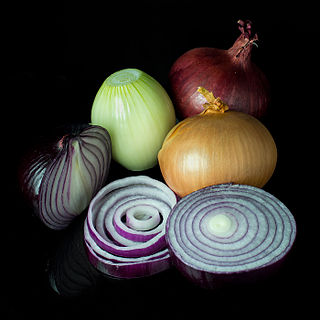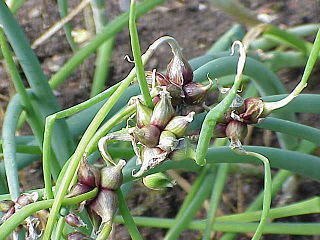
Chives, scientific name Allium schoenoprasum, is a species of flowering plant in the family Amaryllidaceae that produces edible leaves and flowers.

The shallot is a cultivar group of the onion. Until 2010, the shallot was classified as a separate species, Allium ascalonicum. The taxon was synonymized with Allium cepa in 2010, as the difference was too small to justify a separate species.

Garlic is a species of bulbous flowering plant in the genus Allium. Its close relatives include the onion, shallot, leek, chive, Welsh onion, and Chinese onion. It is native to Central Asia, South Asia and northeastern Iran. It has long been used as a seasoning and culinary ingredient worldwide, with a history of several thousand years of human consumption and use, including also use as a traditional medicine. It was known to ancient Egyptians and other ancient cultures for which its consumption has had a significant culinary cultural impact, especially across the Mediterranean region and across parts of Asia. It is produced globally but the largest producer is China which produced 73% of the world's supply of garlic in 2021. There are two subspecies and hundreds of varieties of garlic.

An onion, also known as the bulb onion or common onion, is a vegetable that is the most widely cultivated species of the genus Allium. The shallot is a botanical variety of the onion which was classified as a separate species until 2011. The onion's close relatives include garlic, scallion, leek, and chives.

In botany, a bulb is a short underground stem with fleshy leaves or leaf bases that function as food storage organs during dormancy. In gardening, plants with other kinds of storage organ are also called ornamental bulbous plants or just bulbs.

Allium ursinum, known as wild garlic, ramsons, cowleekes, cows's leek, cowleek, buckrams, broad-leaved garlic, wood garlic, bear leek, Eurasian wild garlic or bear's garlic, is a bulbous perennial flowering plant in the amaryllis family Amaryllidaceae. It is native to Europe and Asia, where it grows in moist woodland. It is a wild relative of onion and garlic, all belonging to the same genus, Allium. There are two recognized subspecies: A. ursinum subsp. ursinum and A. ursinum subsp. ucrainicum.

Allium tuberosum is a species of plant native to the Chinese province of Shanxi, and cultivated and naturalized elsewhere in Asia and around the world. It has a number of uses in Asian cuisine.

Elephant garlic is a plant belonging to the onion genus. It has a tall, solid, flowering stalk, flat leaves. The flavor is milder than garlic and can be eaten raw in salads, roasted, or sauteed, but is generally not a substitute for conventional garlic in cooking. It is sometimes confused with solo garlic.

The tree onion is a perennial plant similar to the common onion (A. cepa), but with a cluster of bulblets where a normal onion would have flowers. Tree onions are also known as topsetting onions, walking onions, or Egyptian onions. Genomic evidence has conclusively shown that they are a diploid hybrid of the shallot and the Welsh onion (A. fistulosum). However, some sources may still treat the tree onion as A. cepa var. proliferum or A. cepa Proliferum Group.

Allium vineale is a perennial, bulb-forming species of wild onion, native to Europe, northwestern Africa and the Middle East. The species was introduced in Australia and North America, where it has become an Invasive species.

Allium canadense, the Canada onion, Canadian garlic, wild garlic, meadow garlic and wild onion is a perennial plant native to eastern North America from Texas to Florida to New Brunswick to Montana. The species is also cultivated in other regions as an ornamental and as a garden culinary herb. The plant is also reportedly naturalized in Cuba.

The pearl onion, also known as button onion, baby onion or silverskin onion in the UK, is a close relative of the leek, and may be distinguished from common onions by having only a single storage leaf, similar to cloves of garlic. In French they are known as oignon grelot. One English-speaking reference also mentions the term petit poireau antillais.

The sand leek, also known as rocambole and Korean pickled-peel garlic, is a Eurasian species of wild onion with a native range extending across much of Europe, Middle East, and Korea. The species should not be confused with rocambole garlic, which is A. sativum var. ophioscorodon.

Garlic powder is a spice that is derived from dehydrated garlic and used in cooking for flavour enhancement. The process of making garlic powder includes drying and dehydrating the vegetable, then powdering it through machinery or home-based appliances depending on the scale of production. Garlic powder is a common component of spice mix. It is also a common component of seasoned salt.

A bulbil is a small, young plant that is reproduced vegetatively from axillary buds on the parent plant's stem or in place of a flower on an inflorescence. These young plants are clones of the parent plant that produced them—they have identical genetic material. The formation of bulbils is a form of asexual reproduction, as they can eventually go on to form new stand-alone plants.

Allium paradoxum, the few-flowered garlic or few-flowered leek, is an Asian species of wild onion in the Amaryllis family. It is native to mountainous regions of Iran, Caucasus, and Turkmenistan and invasive in Europe.

Garlic production in China is significant to the worldwide garlic industry, as China provides 80% of the total world production and is the leading exporter. Following China, other significant garlic producers include India and Bangladesh (1%). As of 2019, China produced 23 million tonnes annually.
Allium rhynchogynum is a Chinese species of wild onion endemic to the Yunnan region in southern China. It grows at elevations of 2700–3200 m.

The Aglio Rosso di Nubia, also known as Aglio di Paceco and Aglio di Trapani, is a Sicilian variety of garlic, characterized by the intense purple color of the robes of its bulbils. It is mainly cultivated in Nubia, a fraction of the comune of Paceco, in the Province of Trapani. In less extent, it is also cultivated in the neighboring municipalities of Trapani, Erice, Buseto Palizzolo, Valderice, Marsala and Salemi.

Allium is a genus of monocotyledonous flowering plants with hundreds of species, including the cultivated onion, garlic, scallion, shallot, leek, and chives. It is one of about 57 genera of flowering plants with more than 500 species. It is by far the largest genus in the Amaryllidaceae, and also in the Alliaceae in classification systems in which that family is recognized as separate.




















